What is a Decagon?
We know that a two-dimensional closed figure having a finite number of sides is known as a polygon. The minimum number of sides required to make a polygon are three. The number of angles in a polygon depends on the number of sides of the polygon. Polygons can be four sided (parallelogram), five sided (pentagon) and so on.
A decagon is simply a ten-sided polygon.

In the above image, different sided polygons are given.
One such type of polygon is a decagon having 10 sides.
Decagon Definition
In geometry, a polygon having ten sides or a ten-sided polygon is called a decagon or ten-gon. It also has ten vertices and ten angles.
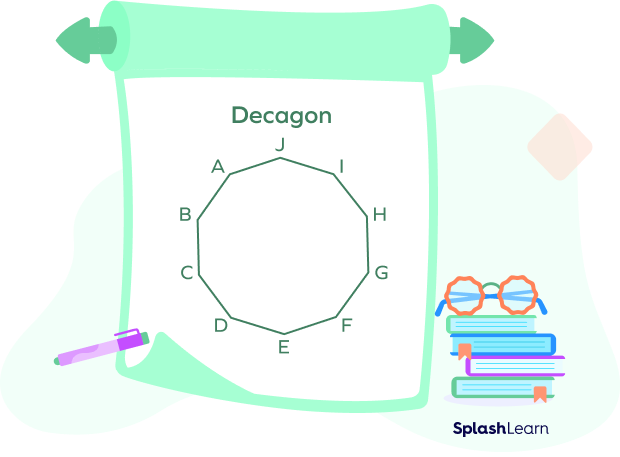
In the above image, there are 10 sides: AB, BC, CD, DE, EF, FG, GH, HI, IJ, and AJ.
There are 10 angles.
Decagon interior angles: $\angle\text{ABC}$, $\angle\text{BCD}$, $\angle\text{CDE}$, $\angle\text{DEF}$, $\angle\text{EFG}$,$\angle\text{FGH}$, $\angle\text{GHI}$, $\angle\text{HIJ}$, $\angle\text{IJA}$, and $\angle\text{JAB}$
There are 10 vertices: A, B, C, D, E, F, G, H, I, and J.
Sum of Interior Angles of a Decagon
The sum of interior angles of a polygon $=(n$$-$$2) \times 360^\circ$ where n is the number of sides.
Since the number of sides, i.e., $n=10$ in a decagon
The sum of interior angles of a decagon $=(10$$-$$2)\times180^\circ=8\times180^\circ=1440^\circ$
Thus, the sum of all the interior angles of a decagon $= 1440^\circ$
Types of Decagon
There are three possible ways in which we can classify decagons that are given below:
- Regular and Irregular Decagons
Regular Decagons
Decagons in which all the sides and angles are equal are known as regular decagons.
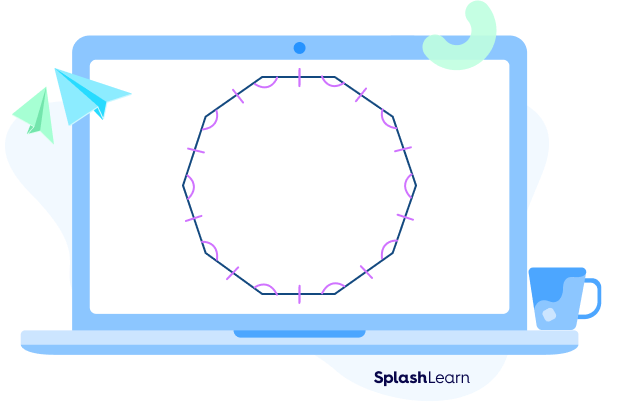
The characteristics of a regular decagon are as follows:
a. All the sides are equal in length and all the angles are equal in measure.
b. Each interior angle of a regular decagon $= \frac{1440^\circ}{10}=144^\circ$
c. Because the sum of exterior angles of a decagon = 360, each exterior angle of a decagon $=\frac{360^\circ}{10}=36^\circ $
d. The central angle is a circle and circle forms $360^\circ $. On drawing 10 diagonals, we get each central angle of a decagon $=\frac{360^\circ}{10}=36^\circ $
e. A regular decagon can be inscribed inside a circle. Also, the circle and the decagon share the same center.
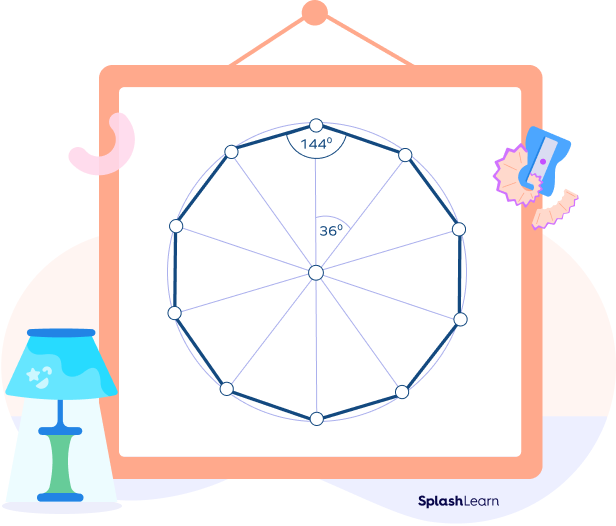
Irregular Decagons
Decagons in which sides and angles are not equal are known as irregular decagons. There should be at least two sides and angles that are different in measurement. Examples of an irregular decagon are given below:

- Convex and Concave Decagons
Convex Decagons
Decagons in which all the interior angles are less than $180^\circ $ is known as convex decagons. Or, a convex decagon is a decagon whose diagonals lie inside it.
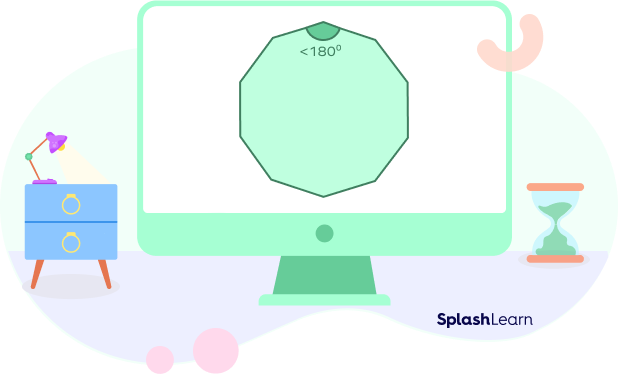
In the above figure, all the diagonals will lie inside the decagon.
Concave Decagons
Concave decagons are the decagons in which at least one interior angle is greater
than $180^\circ $. Or, the decagons that have at least one diagonal that lies outside it are known as the concave decagons.
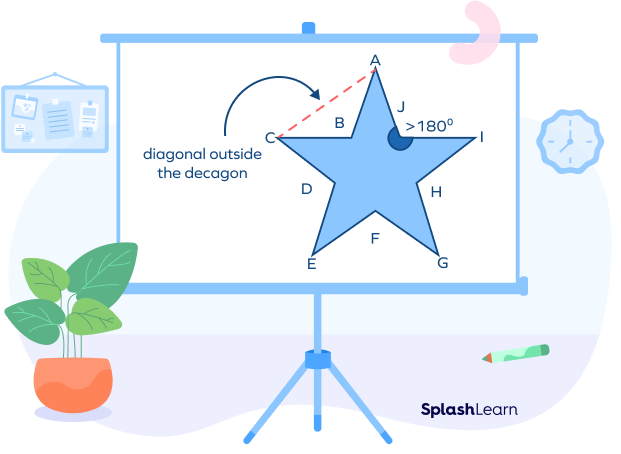
In the above figure, $\angle$AJI is greater than $180^\circ $ and if we join the vertices A and C, the
diagonal will lie outside the decagon.
- Simple and Complex Decagons
Simple Decagons
Simple decagons are the decagons in which no sides cross each other. Also, the diagonals don’t cross each other. A simple decagon can be regular as well as irregular.
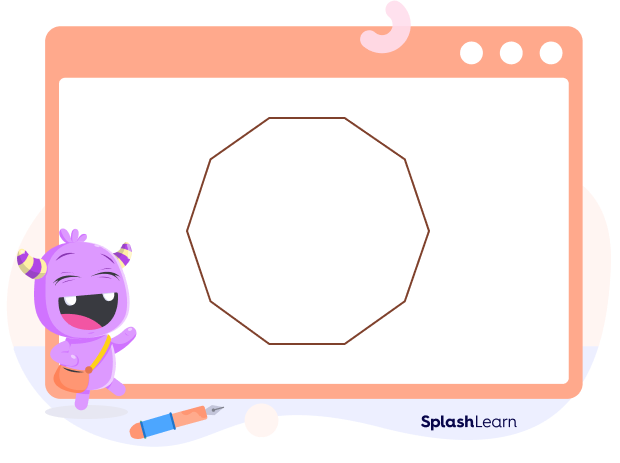
In the above figure, the decagon is a simple decagon with no sides crossing themselves.
Complex Decagons
Complex decagons are the decagons that are self intersecting and there are additional interior spaces.

Number of Triangles and Lines of Symmetry in a Decagon
When we join one vertex to the remaining vertices of the decagon, we get 8 triangles. When we join all the vertices independently to each other, then we get $8 \times 10 = 80$ triangles.
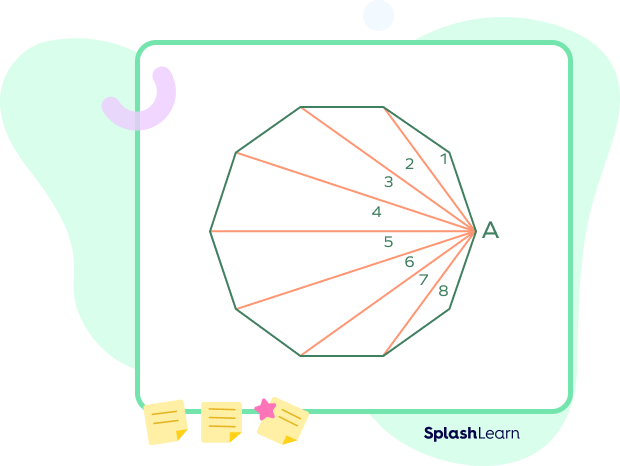
- A regular decagon has 10 lines of symmetry.
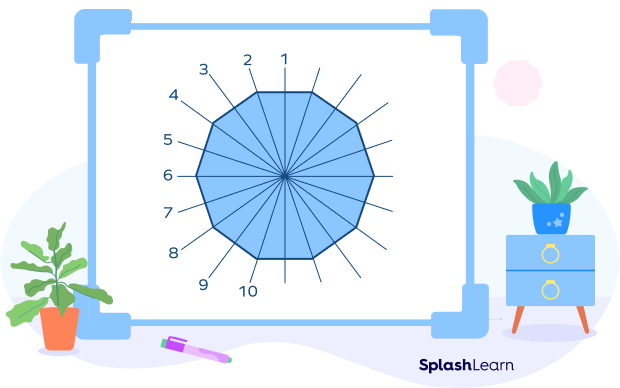
- Irregular decagons may or may not have any line of symmetry.

Number of Diagonals in a Decagon
The number of diagonals of a polygon $=\frac{n(n-3)}{2}$ where $n$ is the number of sides.
Since the number of sides, i.e., $n=10$ in a decagon
So, the number of diagonals in a decagon $=\frac{10\times7}{2}=35$
Area of a Regular Decagon
Area of a regular decagon is the space occupied between the boundary of the decagon. The formula for area of a decagon is given by: $\frac{5a^2}{2}\times\sqrt{5+2}\sqrt{5}$ where $a =$ length of the side of the decagon.
Decagon Facts
- All sides of a regular decagon are the same length.
- Decagram is a regular star polygon. Its vertex positions are the same as the regular decagon.
- A skew decagon is a skew polygon. It has 10 vertices and edges but not existing on the same plane.
Solved Examples
1. Find the perimeter of a regular decagon if the length of a side is 5 units?
Solution: The number of sides of a decagon $= 10$
Since, the decagon is regular. So, all sides will be equal.
Perimeter $= 5\times10 = 50$ units
2. What is the sum of the number of sides, vertices, and angles in an irregular decagon?
Solution: Number of sides of an irregular decagon $= 10$
Number of vertices of an irregular decagon $= 10$
Number of angles of an irregular decagon $= 10$
Sum $= 10 + 10 + 10 = 30$
3. The two interior angles of a decagon are given 200 and 250. Which type of a decagon is it?
Solution: Since, the two interior angles of the decagon given above are more than 180 so, it is called a concave decagon.
4. How many lines of symmetry does a regular decagon have?
Solution: A regular decagon has 10 lines of symmetry.
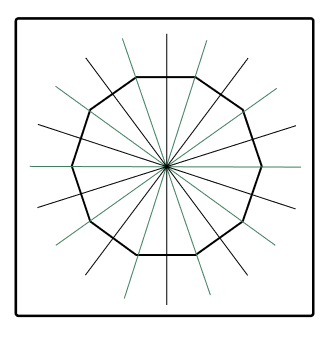
Practice Problems
Decagon - Definition With Examples
Which of the following is not a decagon?
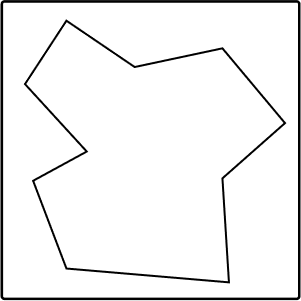
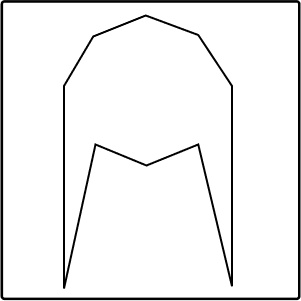
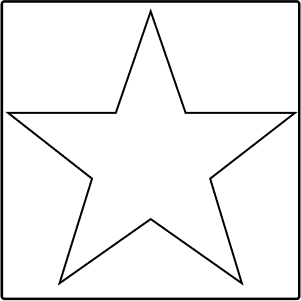
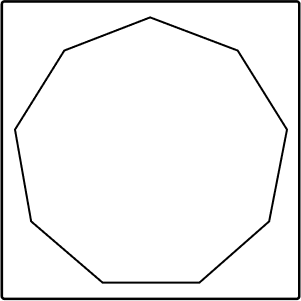
The number of sides in option D are 9. So, it is not a decagon.
Fill in the blanks:
A regular decagon has all sides _________ and the measure of each angle of a regular decagon is _________.
The sides of a regular decagon are equal and the measure of each angle $=\frac{1440^\circ}{10} = 144^\circ$
Which of the following is false for a regular decagon?
The sum of all angles of a decagon $=(n$$-$$2)\times360^\circ=1440^\circ$
Frequently Asked Questions
A decagon is a polygon with ten sides, ten vertices, and ten angles. On the other hand, a dodecagon is a polygon with twelve sides, twelve vertices, and twelve angles.
Can we find decagons in real life?
Decagons can be seen in various things in the surroundings, such as coasters, coins, umbrellas, drums, watches, cutlery, etc. Also, a decagon is an intriguing form of polygons and is widely used while doing wall art.
What is the history of a decagon?
The word “decagon” dates back to the sixteenth century, and is derived from the Latin word decagonum, wherein deca means ten and gonum means angles. So, the word decagon means ten angles.
















